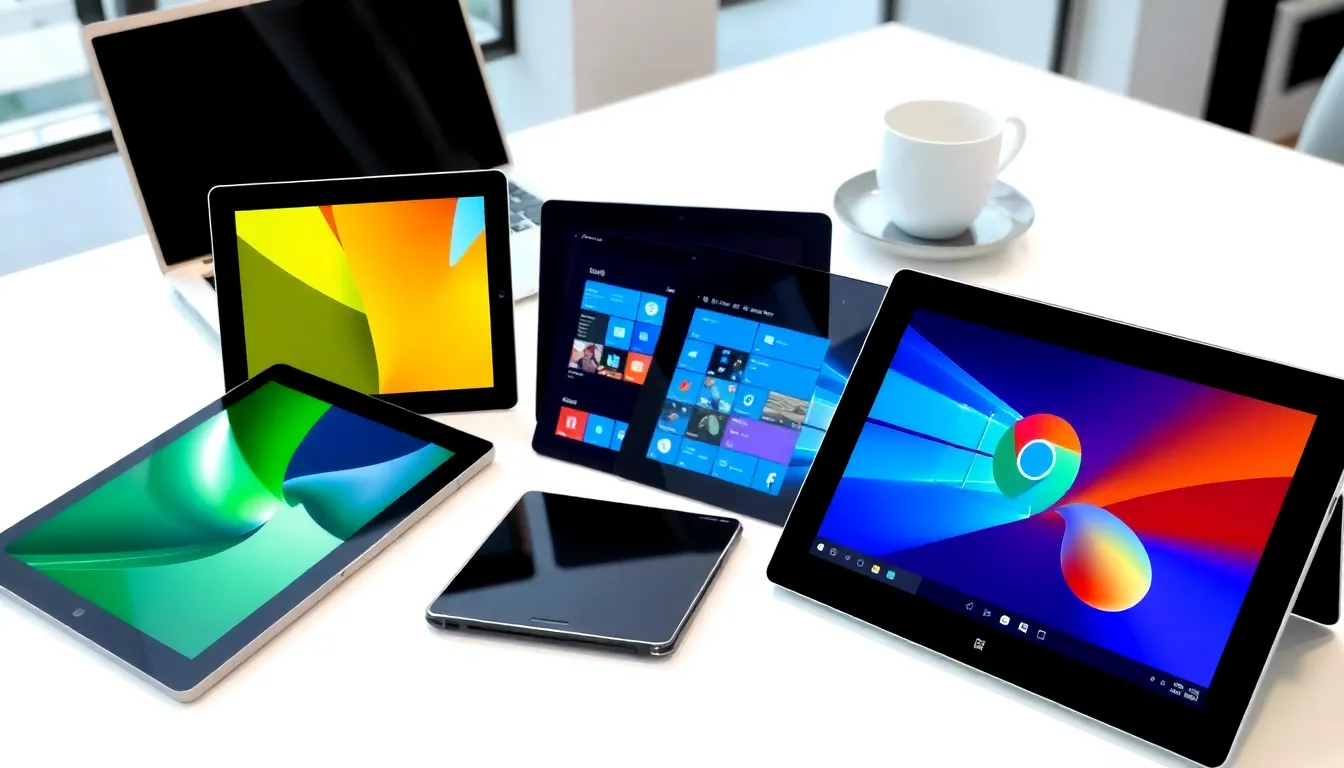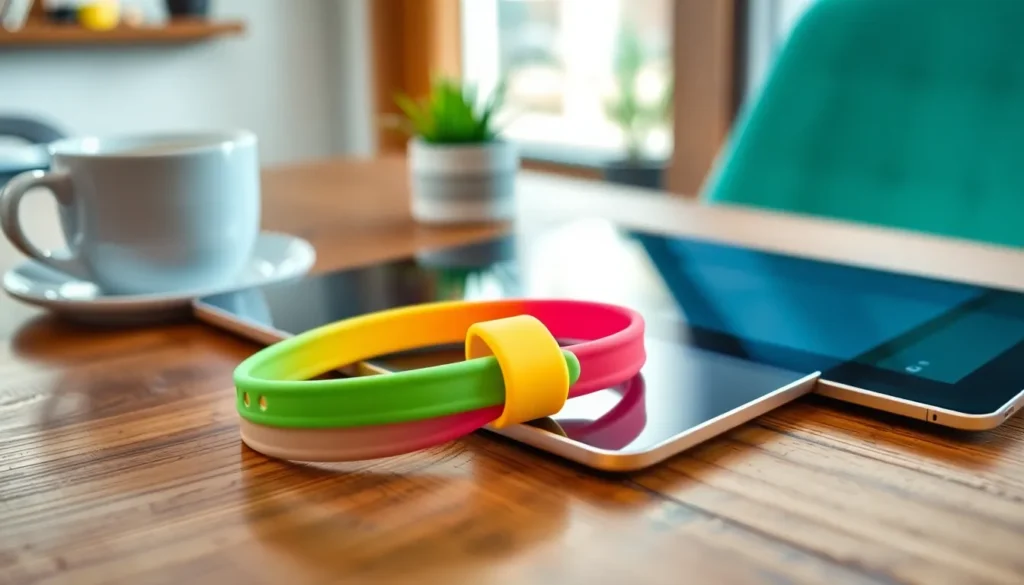Table of Contents
ToggleIn a world where tablets reign supreme, the iPad often takes center stage, but what if there’s a better option lurking in the shadows? With countless alternatives on the market, it’s time to explore devices that might just make you question your loyalty to Apple. Picture this: a sleek, powerful tablet that doesn’t cost an arm and a leg, yet delivers performance that’ll make your iPad jealous.
Overview of iPad Alternatives
Many exceptional tablets offer compelling alternatives to the iPad. Android tablets, like the Samsung Galaxy Tab series, provide robust performance and versatility for users. Microsoft’s Surface Pro line combines tablet functionality with laptop capabilities, appealing to professionals and creatives.
Another example is the Amazon Fire tablet, known for its affordability and solid media consumption experience. It features seamless integration with Amazon services, making it attractive for regular Kindle users.
In addition, Lenovo’s Tab series presents budget-friendly options equipped with decent specs. These tablets cater to casual users looking for reliable performance without breaking the bank.
Chinese manufacturers, such as Xiaomi and Huawei, have also entered the market with competitively priced tablets that offer high specifications. Many users find these options suitable for everyday tasks, including browsing and streaming content.
For students, the Chromebook tablet hybrids deliver Chrome OS’s efficiency combined with the benefits of touch screens. They often provide good performance for educational apps and multitasking capabilities.
When considering iPad alternatives, users have varied needs to address. Factors such as budget, operating system preference, and intended use significantly influence their decisions. Evaluating each option carefully ensures a well-informed choice that aligns with personal requirements.
Popular iPad Alternatives

Numerous tablets compete effectively with the iPad, showcasing diverse features and prices that appeal to different users.
Android Tablets
Android tablets serve as a strong alternative to the iPad. Samsung’s Galaxy Tab series stands out with powerful performance and expandable storage options. Users appreciate its excellent display quality and versatility for multitasking. Google’s Pixel Slate, combining Chrome OS and Android apps, offers a refined experience particularly for those involved in creative work. A variety of Android tablets cater to specific needs, whether consumers prioritize entertainment, productivity, or budget-friendly choices.
Windows Tablets
Windows tablets combine functionality and flexibility for productive tasks. Microsoft’s Surface Pro line excels by providing laptop capabilities within a tablet form factor, appealing to professionals seeking portability and power. Featuring full desktop applications, these devices enhance productivity in any setting. Users gravitate towards the affordability of other Windows tablets like the Lenovo IdeaPad Duet, which delivers solid performance for light tasks. Choices abound for those who prefer a Windows operating system.
Chromebooks
Chromebook tablet hybrids feature the efficiency of Chrome OS with touchscreen usability. These devices attract users seeking a lightweight, user-friendly option for browsing and media. The HP Chromebook x2 offers a detachable keyboard, transforming from tablet to laptop seamlessly. Battery life often exceeds expectations, making these devices suitable for on-the-go users. Students frequently choose Chromebooks for their affordability and compatibility with Google’s suite of productivity tools. The blend of functionality and price makes them a smart alternative for diverse needs.
Key Features to Consider
When choosing an iPad alternative, several key features play vital roles in decision-making. Prioritizing these aspects ensures a more satisfying user experience.
Performance
A powerful processor significantly impacts performance. Tablets like the Samsung Galaxy Tab S series utilize high-performance chipsets, enhancing multitasking capabilities. Similarly, Microsoft’s Surface Pro series combines Intel processors with efficient RAM options, catering to professional needs. Understanding the difference in processing speed and system capabilities helps in selecting a device that meets specific requirements. Gamers and heavy users benefit from devices with ample processing power, facilitating seamless operation during resource-intensive tasks.
Display Quality
Display quality proves essential for the overall user experience. Tablets should feature high resolution and vibrant color reproduction for optimal visual enjoyment. The Samsung Galaxy Tab line excels with Super AMOLED displays, delivering stunning graphics for entertainment. In contrast, the Microsoft Surface devices offer high-resolution screens suitable for both productivity and creative work. Evaluating brightness levels and viewing angles aids in selecting a tablet that provides comfortable viewing for various activities, ensuring a satisfying visual experience in any setting.
Battery Life
Battery life influences how long a tablet can perform without charging. Users often prefer devices that last all day on a single charge. Tablets like the Lenovo Tab series have outstanding battery longevity, perfect for casual users who require durability. The Microsoft Surface Pro devices also offer impressive battery performance, appealing to professionals needing dependable power during lengthy work sessions. Comparing battery capacity and real-world performance helps users choose a tablet that aligns with their daily routines, ensuring uninterrupted usage throughout the day.
Price Comparison
Evaluating the price of iPad alternatives is crucial for making cost-effective decisions. Samsung Galaxy Tab series tablets range from $200 to $1,000, depending on specifications. Microsoft Surface Pro devices generally start around $800 and can exceed $2,000 for higher configurations.
Amazon Fire tablets offer impressively low prices, typically between $50 and $200, making them a popular choice for budget-conscious buyers. Lenovo Tab series can be found for about $100 to $500, providing solid performance at an affordable price point.
Chromebook tablet hybrids also present competitive pricing, with numerous models available between $300 and $700. Chinese manufacturers like Xiaomi and Huawei usually price their tablets around $250 to $600, showcasing high specs driven by demand.
In terms of cost-to-performance ratio, budget options like the Lenovo IdeaPad Duet and Amazon Fire tablets stand out for casual use, while Samsung Galaxy Tabs and Microsoft Surfaces are advantageous for professionals. Each alternative caters to different user needs, ensuring a suitable choice for various budgets.
Total ownership cost is another aspect worth considering. Additional expenses such as accessories, warranties, and apps can accumulate. Many devices support a wide range of productivity and entertainment apps, enhancing user value regardless of the initial purchase price.
Comparing featured specifications against price allows users to identify the best alternatives to the iPad while considering their specific requirements. The emphasis on price facilitates finding a balance between affordability and functionality, essential for any tech-savvy individual.
Pros and Cons of iPad Alternatives
Evaluating iPad alternatives involves examining both benefits and drawbacks.
Pros:
- Cost-Effectiveness: Many alternatives offer significant savings. For instance, Amazon Fire tablets typically range from $50 to $200, making them budget-friendly for casual users.
- Diverse Operating Systems: Android and Windows tablets provide varied ecosystems, enhancing user experience. The Samsung Galaxy Tab series excels in running Android, while Microsoft’s Surface Pro offers a Windows environment, catering to different preferences.
- Versatile Functionality: Tablets like the Microsoft Surface Pro combine tablet and laptop features, addressing productivity needs. Creative professionals often favor these devices for their robust performance.
- Variety of Choices: A wide array of brands includes options from Lenovo to Xiaomi, ensuring users find a tablet that meets their specific needs. Different specifications allow customization based on user requirements.
Cons:
- Compatibility Issues: Some tablets may face challenges with application compatibility. This can be problematic for users reliant on specific apps available on iOS devices.
- Build Quality Variances: Alternatives sometimes lack the premium build quality associated with Apple products. Devices from lesser-known manufacturers may not match the durability of an iPad.
- Software Updates: The frequency and longevity of software updates might not match Apple’s offerings. Some brands may offer limited updates, affecting device longevity and security.
- Support Limitations: Not all manufacturers provide effective customer support. This could lead to difficulties in troubleshooting and maintenance for users.
Weighing these pros and cons aids in making an informed decision on the best iPad alternative for specific needs.
Exploring iPad alternatives opens up a world of options that cater to various needs and budgets. With powerful Android tablets like the Samsung Galaxy Tab and versatile devices such as the Microsoft Surface Pro, users can find tailored solutions that enhance productivity and entertainment. Budget-friendly choices like the Amazon Fire tablet and Lenovo Tab series provide solid performance without breaking the bank.
By carefully considering features like performance, display quality, and battery life alongside pricing, users can make informed decisions. Evaluating the pros and cons of each device helps ensure that the chosen tablet aligns perfectly with individual requirements. The right alternative can offer exceptional value and performance, making it a worthy contender against the iPad.





